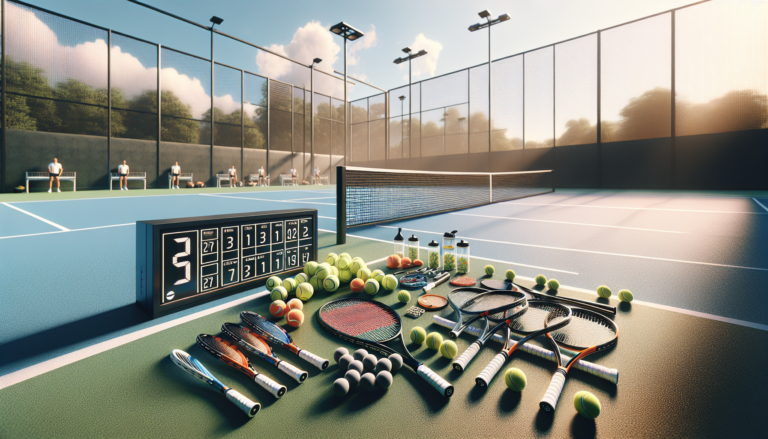Introduction to Tennis Strategy
Tennis is a thrilling and competitive sport that requires a combination of physical prowess, mental toughness, and strategic thinking. Whether you’re a beginner looking to improve your game or an experienced player aiming to take your skills to the next level, understanding and implementing effective tennis strategies is essential. In this comprehensive guide, we’ll explore the key elements of a successful tennis strategy and delve into the essential tactics that can elevate your game.
The Importance of Strategy in Tennis
In tennis, having a clear strategy is crucial for maximizing your performance on the court. A well-defined strategy provides you with a roadmap, helping you stay focused and make better decisions under pressure. It allows you to capitalize on your strengths, exploit your opponent’s weaknesses, and adapt to different playing styles and conditions. By developing a solid strategic foundation, you can enhance your consistency, increase your chances of winning points, and ultimately emerge victorious in matches.
Key Elements of a Successful Tennis Strategy
A successful tennis strategy encompasses several key elements. First and foremost, it involves maintaining depth in your shots. By hitting deep into your opponent’s court, you can keep them on the defensive and reduce the risk of unforced errors. Additionally, targeting your opponent’s weaknesses is a crucial aspect of an effective strategy. Whether it’s exploiting their weaker side or targeting their less reliable shots, putting pressure on their vulnerabilities can give you a significant advantage.
Another essential element is controlled aggression. While it’s important to play aggressively and take control of the point, it’s equally vital to manage your risk-taking. Striking a balance between aggressive shot-making and minimizing errors is key to success. Lastly, managing pressure points effectively is a hallmark of a strong tennis strategy. Being able to perform under stress, particularly during critical moments like game points or break points, can make all the difference in a match.
Essential Tactics to Elevate Your Game
Now that we’ve covered the fundamental aspects of tennis strategy, let’s dive into the essential tactics that can take your game to new heights.
Out-Rally the Opponent
One of the most effective tactics in tennis is to out-rally your opponent. This strategy revolves around consistency and depth, aiming to keep the ball in play and force your opponent to make mistakes. By focusing on hitting deep, consistent shots and minimizing unforced errors, you can gradually wear down your opponent and gain the upper hand in rallies. Mastering the art of out-rallying requires patience, discipline, and a keen understanding of your own strengths and limitations.
Play Aggressively
While consistency is important, there are times when playing aggressively can be highly beneficial. Taking control of the point by hitting powerful shots and applying constant pressure can put your opponent on the back foot. Aggressive play involves seizing opportunities to hit winners, attacking short balls, and taking calculated risks. However, it’s crucial to strike a balance between aggression and control to avoid reckless mistakes.
Play Your Strengths
Every player has unique strengths and natural abilities. Whether it’s a formidable serve, a blistering forehand, or exceptional court coverage, recognizing and leveraging your strengths is essential for success. By building your game around your strengths, you can create a solid foundation and force your opponent to adapt to your style of play. Identify your most reliable shots and patterns, and look for opportunities to utilize them during matches.
Hit the Ball to the Opponent’s Weakness
Just as it’s important to play to your own strengths, it’s equally crucial to exploit your opponent’s weaknesses. Observe their game closely and identify areas where they struggle or feel less comfortable. This could be a particular shot, such as a weak backhand, or a specific area of the court they have trouble covering. By consistently targeting their weaknesses, you can put them under pressure, force errors, and gain a strategic advantage.
Attack the Net
Attacking the net is a powerful tactic that can catch your opponent off guard and put them on the defensive. By moving forward and taking the net, you can cut off angles, hit volleys, and apply pressure. This tactic is particularly effective when you have a strong serve or when you receive a short ball that allows you to approach the net with confidence. However, it’s important to pick your moments wisely and ensure that you have a solid volley game to back up your net play.
Bring the Opponent to the Net
While attacking the net yourself can be advantageous, bringing your opponent to the net can also be a smart strategic move. By hitting short, low balls or well-placed drop shots, you can force your opponent to move forward and leave their comfort zone at the baseline. This can create opportunities for you to hit passing shots or lobs, exploiting their potentially weaker net game. Drawing your opponent to the net can disrupt their rhythm and force them to play uncomfortable shots.
Use Variety to Create Mistakes or Short Balls
Incorporating variety into your game is a powerful way to keep your opponent guessing and create opportunities for yourself. Mix up your shots, vary your spins, and change the pace and depth of your balls. By using a diverse array of strokes, you can prevent your opponent from settling into a comfortable rhythm and force them to adapt constantly. This can lead to mistakes on their part or short balls that you can capitalize on.
Open the Court
Opening up the court is a fundamental tactic in tennis. By hitting shots that force your opponent to move laterally or diagonally, you can create space and angles to exploit. This can be achieved through well-placed serves, angled groundstrokes, or strategically hit volleys. By opening up the court, you give yourself more options for shot selection and make it harder for your opponent to defend effectively.
Improving Your Consistency
Consistency is a cornerstone of a successful tennis game. Being able to hit shots reliably and minimize unforced errors can give you a significant advantage over your opponent. Let’s explore some drills and techniques to enhance your consistency on the court.
Drills to Improve Consistency
Incorporating specific drills into your practice routine can help you develop greater consistency in your shots. One effective drill is to set a target on the court, such as a cone or a specific spot, and aim to hit that target repeatedly. Start with a manageable distance and gradually increase the challenge as you improve. Another useful drill is to practice hitting alternating crosscourt and down-the-line shots, focusing on maintaining depth and control.
Rally with a Partner
Rallying with a partner is an excellent way to improve your consistency and build endurance. Find a practice partner of a similar skill level and engage in extended rallies, aiming to keep the ball in play for as long as possible. Focus on hitting deep, consistent shots and challenge each other to maintain a steady rhythm. As you become more comfortable, introduce variations like changing the direction or height of your shots to simulate match-like situations.
Advanced Concepts in Tennis Strategy
As you progress in your tennis journey, exploring advanced concepts can take your strategic understanding to new levels. Let’s delve into some higher-level strategic considerations.
Controlled Aggression
Controlled aggression is a strategic approach that balances risk-taking with precision. It involves playing aggressively while maintaining a high level of control over your shots. Instead of recklessly going for winners, focus on hitting powerful shots to big targets and punishing short balls when the opportunity arises. Controlled aggression allows you to apply pressure on your opponent while minimizing the risk of unforced errors.
Reducing Errors
In tennis, the majority of points end in errors rather than winners. Therefore, reducing your own errors is crucial for success. Develop a keen awareness of your shot selection and decision-making process. Avoid attempting low-percentage shots or taking unnecessary risks, especially during critical moments. Focus on hitting high-percentage shots, aiming for large targets, and letting your opponent make the mistakes.
Understanding Tennis IQ
Tennis IQ refers to a player’s overall understanding of the game, including strategic decision-making, shot selection, and situational awareness. Developing a high tennis IQ involves studying the game, analyzing your own strengths and weaknesses, and adapting to different playing styles and conditions. It also encompasses the ability to read your opponent’s tendencies, anticipate their shots, and make quick adjustments based on the flow of the match.
Managing Pressure Points
Pressure points are pivotal moments in a tennis match where the outcome can be significantly influenced. These include game points, break points, and set points. Managing these high-pressure situations effectively is a hallmark of a strong mental game. Develop strategies to cope with pressure, such as focusing on your breathing, maintaining a positive mindset, and sticking to your game plan. Embrace the challenge and view pressure points as opportunities to showcase your skills and determination.
Maintaining Depth
Maintaining depth in your shots is a fundamental aspect of tennis strategy. Deep shots push your opponent back and limit their offensive options. Aim to consistently hit the ball past the service line, forcing your opponent to hit from an uncomfortable position. By keeping the ball deep, you can control the pace of the rally, reduce the risk of your opponent attacking, and create opportunities to move forward and take control of the point.
Optimizing Rally Length
The length of rallies can vary significantly based on the playing styles of both you and your opponent. Understanding how to optimize rally length to your advantage is a valuable strategic skill. If you excel in longer rallies, focus on extending the points and wearing down your opponent. If you prefer shorter rallies, look for opportunities to end points quickly through aggressive shot-making or well-timed approaches to the net.
Wardlaw Directionals
The Wardlaw Directionals is a strategic concept that suggests hitting crosscourt shots until a clear opportunity to hit down the line arises. By consistently hitting crosscourt, you can keep the ball in play, maintain a higher margin for error, and wait for the right moment to surprise your opponent with a change of direction. This strategy is particularly effective for players who are developing their game and aiming to build consistency.
Fibonacci Sequencing in Tennis
Fibonacci sequencing is a mathematical concept that some players believe can be applied to tennis strategy. The idea is to use the Fibonacci sequence (1, 1, 2, 3, 5, 8, 13, etc.) to guide shot selection and patterns. For example, hitting one crosscourt shot, followed by another crosscourt, then two down the line, three inside-out, and so on. While the effectiveness of this approach is debatable, experimenting with different patterns can add an element of unpredictability to your game.
Conclusion
Recap of Essential Tactics
In this comprehensive guide, we’ve explored a wide range of essential tactics and strategies to elevate your tennis game. From out-rallying your opponent and playing aggressively to exploiting weaknesses and using variety, these tactics form the foundation of a well-rounded strategic approach. Remember to focus on consistency, depth, and controlled aggression while adapting to your opponent’s style and the match situation.
Final Thoughts on Elevating Your Game
Incorporating these strategies and tactics into your game takes time, practice, and dedication. Be patient with yourself as you work on implementing new concepts and refining your skills. Embrace the process of continuous learning and growth, both on and off the court. Study the game, analyze your own performances, and seek feedback from coaches or experienced players.
Remember that success in tennis is not just about executing strategies flawlessly; it’s also about developing mental resilience, staying focused under pressure, and maintaining a positive attitude. Cultivate a growth mindset, learn from your mistakes, and celebrate your successes along the way.
As you continue your tennis journey, keep an open mind and be willing to adapt your strategy based on your own strengths, your opponent’s playing style, and the demands of each unique match. Trust in your abilities, stay committed to your game plan, and most importantly, enjoy the process of becoming a more strategic and well-rounded tennis player.
With dedication, hard work, and a strategic approach, you have the power to elevate your tennis game to new heights. Embrace the challenge, stay focused on your goals, and let your passion for the sport shine through in every shot you hit. The court is yours to conquer, one point at a time.






